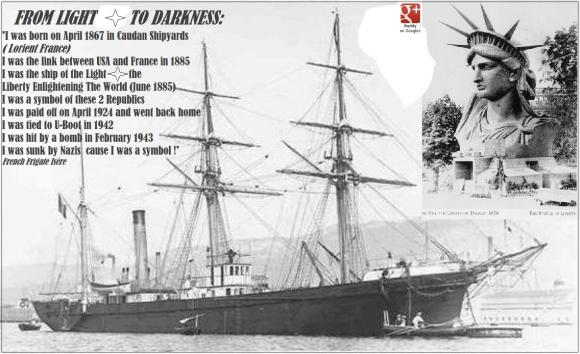 Today’s “Google Doodle,” the changing graphic that appears at the top of the Google search page, is a whimsical memorial to the arrival of the Statue of Liberty in New York. “Google is celebrating America’s most famous gift from France today with a logo marking the Statue of Liberty’s arrival in the New York Harbor 130 years ago on June 17, 1885.”
Today’s “Google Doodle,” the changing graphic that appears at the top of the Google search page, is a whimsical memorial to the arrival of the Statue of Liberty in New York. “Google is celebrating America’s most famous gift from France today with a logo marking the Statue of Liberty’s arrival in the New York Harbor 130 years ago on June 17, 1885.”
Many sources put the arrival of the Statue of Liberty in New York as two days later on the June 19th. Likewise, the Google Doodle takes artistic license in showing the Statue of Liberty teetering on the deck of a tiny generic steam ship. So when and how did the Statue of Liberty arrive in New York?
The copper statue, “Liberty Enlightening the World,” designed by Frédéric Auguste Bartholdi, was loaded into the French navy transport ship Insere as 350 individual pieces, packaged in more than 200 crates. The Insere is often referred to as a frigate, but arrived in New York serving as a cargo vessel, without guns aboard. The ship was a propeller driven steam ship with three masts, around 215 feet long with 30 feet of beam. Here is how the New York Times reported her arrival in an article dated June 18, 1885.
“A pilot boat sailing around in search of one of the big transatlantic steamers, about 10 miles off Sandy Hook Lightship, on Tuesday night, ran close under the bows of an odd-looking, bark rigger propeller, with her hull painted white, and a high funnel between the main and the mizzen masts. The man on lookout shouted down the companionway to the pilots that he thought it was a tramp. The vessel was hailed and a voice answered, “What ship?”
“Isere, from Rouen” came back though the darkness, in broken English.
“It’s all right,” said Pilot Henderson, getting into a small boat and heading for the vessel; “she’s got that big Liberty aboard.”
The ship, which appears to have arrived on June 16th, could not cross the harbor bar because a gale blew up, so she anchored offshore. The voyage had been rough at times. Again, from the NY Times:
Capt. De Saune … said that the Insere had been tossed about in rough weather between Rouen and Fayal. To make bad matters worse, the coal gave out and she had to make sail. After leaving Fayal the weather was lovely and the steamer made rapid time.
The colossal statue weighs 220 tons, and is packed away below decks in 212 boxes, some of them 20 feet long. It took 17 days to stow them away so as to prevent shifting when the vessel rolled and tossed in the tremendous billows. The work was well done, for Lieut. Amet said that not a box moved from its place, though in the early part of the voyage there was ample provocation.
With the news of Insere’s arrival, French Admiral LaCombe set out on the French warship La Flore from Newport , RI, bound for New York to welcome Insere. On the 17th, Insere, crossed the bar into New York harbor and anchored in Gravesend Bay to await welcoming the ceremonies.
On the 19th, Insere was escorted to Bedloes Island by the war ships Powhatan, Omaha, Alliance and La Flore as well as the steamer Dispatch, the ferryboat Atlantic and several private steamers. On land, the Seventy-first, Twelfth and Sixty-ninth Regiments, with the Rochambeau and Lafayette Guards, marched up Broadway from the Battery to City Hall.
So when did the Insere arrive with the crated Statue of Liberty? On the 17th or the 19th? Take your pick. She crossed the bar on the 17th but actually arrived at Bedloes Island, now called Liberty Island where the statue resides, with full pomp and ceremony on the 19th.
The steamer Insere apparently survived until 1943 when she was sunk during World War II.

Photo: frederic.petitdieulois.perso.sfr.fr

thx for the pic and history of the vessel Insere.
Yes, Google does go nuts sometimes.
Especially when they turn their new coders loose!
Hi,
Very interesting web page, thank you!
Clarifying a few points:
1. You’ve accidentally used the name “Insere” for the ship which transported the Statue of Liberty in 1885. The correct name (as quoted in the 1885 NY Times article, is “Isere” (or, rendered correctly in French, “Isère”).
2. I can’t find any evidence supporting the claim that Isère was “sunk” by the Germans because she was “a symbol.”
Rather, it seems that Isere was removed from service in 1911, and her hulk was berthed in the harbor at Lorient. After Lorient was captured by the Germans in 1940, they used the hulk as a berth for U-boats (“tied to U-boats,” as mentioned above). After she was badly damaged in a 1943 RAF bombing raid on Lorient, she was towed out of the harbor by the Germans, who scuttled her.
Details: http://uboat.net/forums/read.php?3,82692,82694#msg-82694
3. The Isère, which transported the Statue of Liberty in 1885 (built 1863, barque fitted with both a steam engine and sail), is not to be confused with another French ship, SS Isère (steamship built 1867, sunk by German U-boat in 1917).
Details:
History of barque “Isère” (built 1863): http://www.wrecksite.eu/wreck.aspx?242785
Scuttling of Isère (1943, WW II): http://uboat.net/forums/read.php?3,82692,82694#msg-82694
History of steamship “SS Isère” (built 1867): http://www.wrecksite.eu/wreck.aspx?148239
Sinking of S.S. Isère (1917, WW I): http://uboat.net/wwi/ships_hit/3069.html
Here’s a photo of the Isère hulk (“pontoon”) berthing a U-boat:
http://www.wrecksite.eu/wreck.aspx?242785